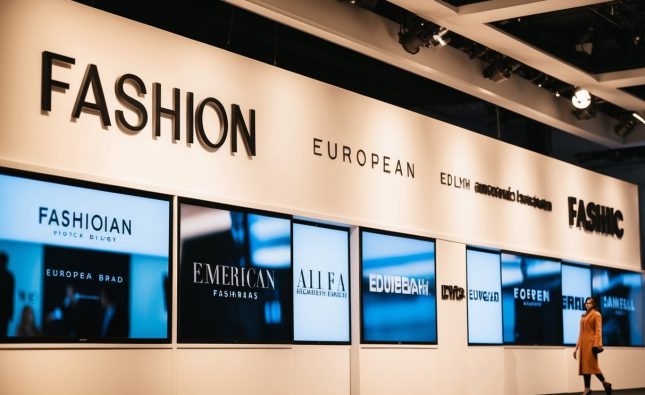
American fashion brands have long played a pivotal role in shaping global style trends. From high-end couture to everyday wear, these brands not only reflect the culture but also set the standard for innovation and quality in the fashion industry. Some of the most iconic American fashion brands, including Ralph Lauren, Levi’s, and Calvin Klein, epitomize a blend of classic styles and modern sensibility that continues to resonate worldwide.

These brands are steeped in history and often draw inspiration from the American landscape and lifestyle. Each has created a unique identity that speaks to diverse audiences, making them household names. Their influence extends beyond clothing, impacting art, music, and social movements, which adds depth to their significance in American culture.
Understanding the cultural footprint of these brands reveals much about American identity and values. Their creations have not only dressed generations but also narrated stories of innovation, resilience, and creativity that define the American ethos.
Evolution of American Fashion
American fashion has transformed significantly over the decades, reflecting changes in society, culture, and technology. From the post-war era’s embrace of casual wear to the rise of streetwear influenced by hip-hop culture, each phase has left a lasting impact. Recent trends toward technology and sustainability continue to shape the landscape, emphasizing innovation and environmental responsibility.
Post-War Influence and the Rise of Casual Wear
After World War II, American fashion experienced a shift towards more casual styles. Soldiers returning home influenced the desire for comfort and practicality in clothing. Denim, for example, emerged as a staple in everyday wear, symbolizing both ruggedness and leisure.
The 1950s and 1960s saw brands like Levi’s and Wrangler popularizing jeans beyond workwear. Casual shirts, polos, and loafers became essential components of American wardrobes. The importance placed on leisure and comfort became evident in the adoption of these styles by all age groups.
Subcultures in this era further diversified fashion. The Beat Generation promoted a more relaxed aesthetic, which set the stage for future trends in casual fashion.
Hip-Hop and the Emergence of Streetwear
The late 20th century marked the rise of hip-hop culture, significantly shaping American fashion. Artists like Run-D.M.C. and Public Enemy popularized urban styles characterized by oversized clothing, athletic gear, and bold accessories. This era emphasized individual expression and cultural pride through fashion.
Streetwear brands such as Supreme and Stüssy emerged, blending elements from skateboarding, graffiti, and hip-hop. Graphic tees, hoodies, and sneakers became essential wardrobe items. This movement not only catered to youth culture but also made waves in high fashion, with luxury brands incorporating street style into their collections.
Streetwear continues to evolve, maintaining relevance through collaborations and innovative designs that reflect current trends and social issues.
Technology and Sustainability Trends
Recent years have witnessed the intersection of technology and fashion, with advancements shaping production processes and consumer experience. 3D printing and smart textiles are two technological innovations redefining how garments are made and worn.
Sustainability has also become a central theme in American fashion. Brands are increasingly adopting eco-friendly materials and ethical practices. Recycling, upcycling, and responsible sourcing are now essential considerations for both consumers and manufacturers alike.
Notable examples include brands like Everlane and Reformation, which prioritize transparency and sustainability. This focus not only caters to a growing environmentally conscious consumer base but also shapes future industry standards.
Iconic American Fashion Brands
Several American fashion brands have shaped the landscape of style with their unique aesthetics and cultural significance. Each brand embodies distinct elements that reflect American heritage and trends.
Ralph Lauren and Preppy Style
Ralph Lauren is synonymous with preppy fashion. Founded in 1967, it has defined the quintessential American look characterized by polo shirts, tailored blazers, and classic chinos.
The brand’s imagery often evokes an upper-class lifestyle, combining sports themes with rustic influences. Iconic pieces like the polo shirt have become staples in casual wardrobes across the globe.
Lauren’s focus on branding and lifestyle marketing has set industry standards. His vision goes beyond clothing to encompass a lifestyle that resonates with sophistication and timelessness.
Tommy Hilfiger’s Classic American Cool
Tommy Hilfiger launched his brand in 1985, quickly establishing a reputation for classic American cool. The brand cleverly merges a relaxed aesthetic with a spirited, youthful vibe.
Distinguished by the red, white, and blue logo, Hilfiger’s designs often feature bold colors and relaxed fits. The brand initially gained traction in the music scene, representing the spirit of the 90s.
Collaborations with celebrities further cemented its cultural relevance. Hilfiger’s ability to blend tradition with modernity showcases its enduring appeal across generations.
Calvin Klein and Understated Elegance
Calvin Klein, founded in 1968, is celebrated for its minimalist design approach. The brand epitomizes understated elegance, with a focus on clean lines and simple silhouettes.
Klein popularized the concept of “less is more,” particularly through its iconic denim jeans and classic underwear lines. The brand often relies on provocative advertising to capture attention.
Innovation in fabric and design repeatedly positions Calvin Klein as a leader in American fashion. It effectively balances casual and formal wear, appealing to a broad audience.
Nike and the Athletic Apparel Revolution
Nike began as a running shoe company in 1964 and evolved into a global leader in athletic apparel. The brand revolutionized how sportswear is perceived and worn.
With a focus on innovation, Nike introduced groundbreaking technologies like Dri-FIT and Air. These advancements have changed the athletic experience and performance standards.
Nike’s marketing strategies often feature high-profile athletes, enhancing brand recognition and aspiration. It combines style with function, appealing to both athletes and fashion-conscious consumers.
Influence on Global Fashion

American fashion brands have significantly shaped trends and styles worldwide. Their impact draws from cultural exports, including Hollywood and the widespread adoption of casual styles.
Hollywood Glamour and Red Carpet Fashion
Hollywood has long served as a beacon of style, influencing global fashion trends. The red carpet showcases creations from iconic American designers like Calvin Klein, Ralph Lauren, and Vera Wang. These events amplify their work, making it accessible to international audiences.
Actresses often wear unique designs, transforming them into aspirational fashion. This exposure encourages trends that fans worldwide emulate. American brands capitalize on this visibility, boosting their global market presence.
Key elements include:
- Luxury: High-end brands emphasize exclusivity and prestige.
- Trendsetting: Styles debuted on the red carpet quickly become mainstream.
- Celebrity Influence: Stars become global style icons, impacting consumers’ purchasing decisions.
Adoption of Denim Worldwide
Denim is synonymous with American culture and has become a global staple. This fabric, originally designed for workwear, has evolved into a versatile fashion item. American brands like Levi’s and Wrangler played crucial roles in this transformation.
Denim’s adaptability allows it to transcend age, gender, and cultural barriers. From high fashion runways to street style, it remains a favorite. Key aspects of denim’s global influence include:
- Casualization: Denim has revolutionized everyday clothing.
- Sustainability Initiatives: Brands now focus on eco-friendly production.
- Cultural Symbolism: Denim reflects identity and lifestyle choices across demographics.
This enduring appeal illustrates how American brands have cultivated a dynamic relationship with global fashion.












